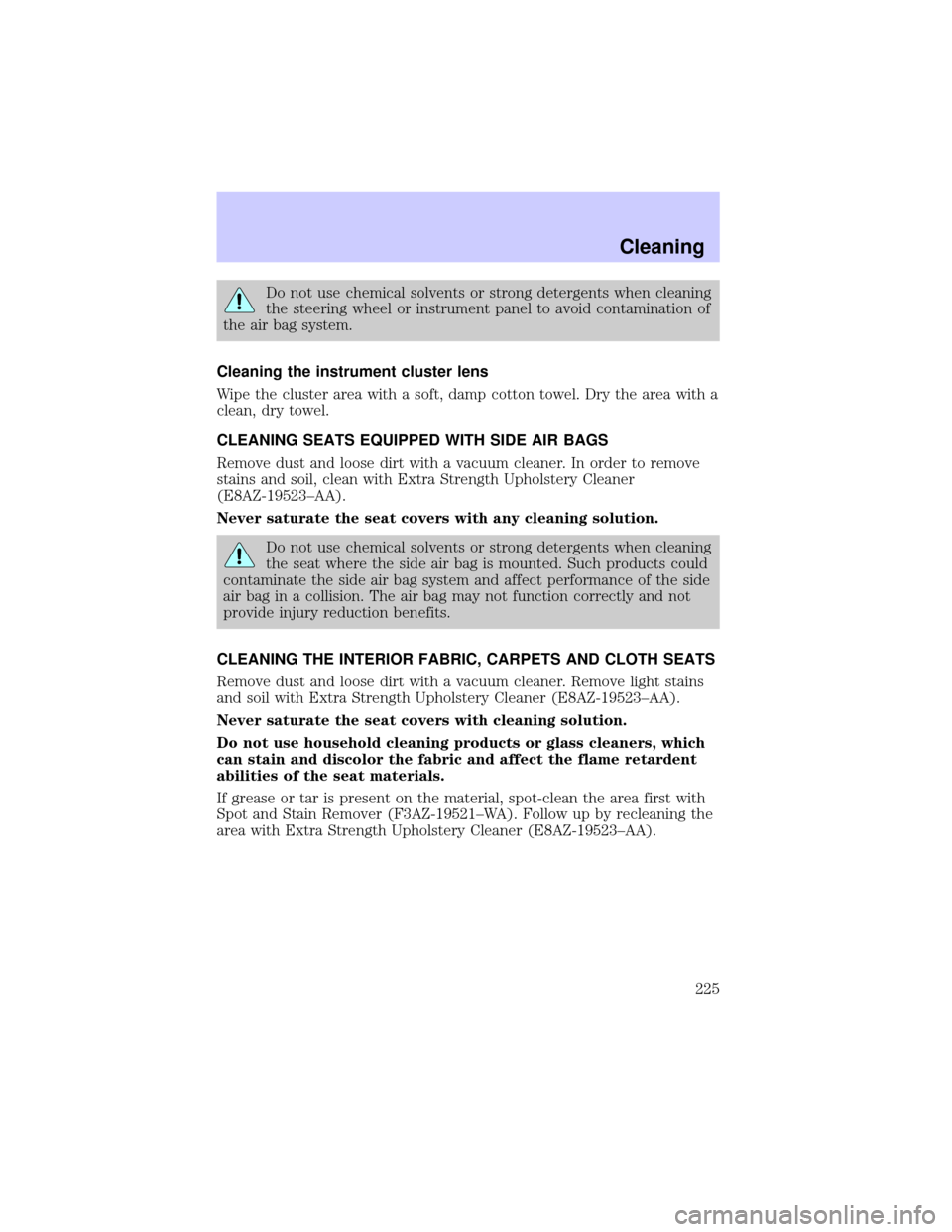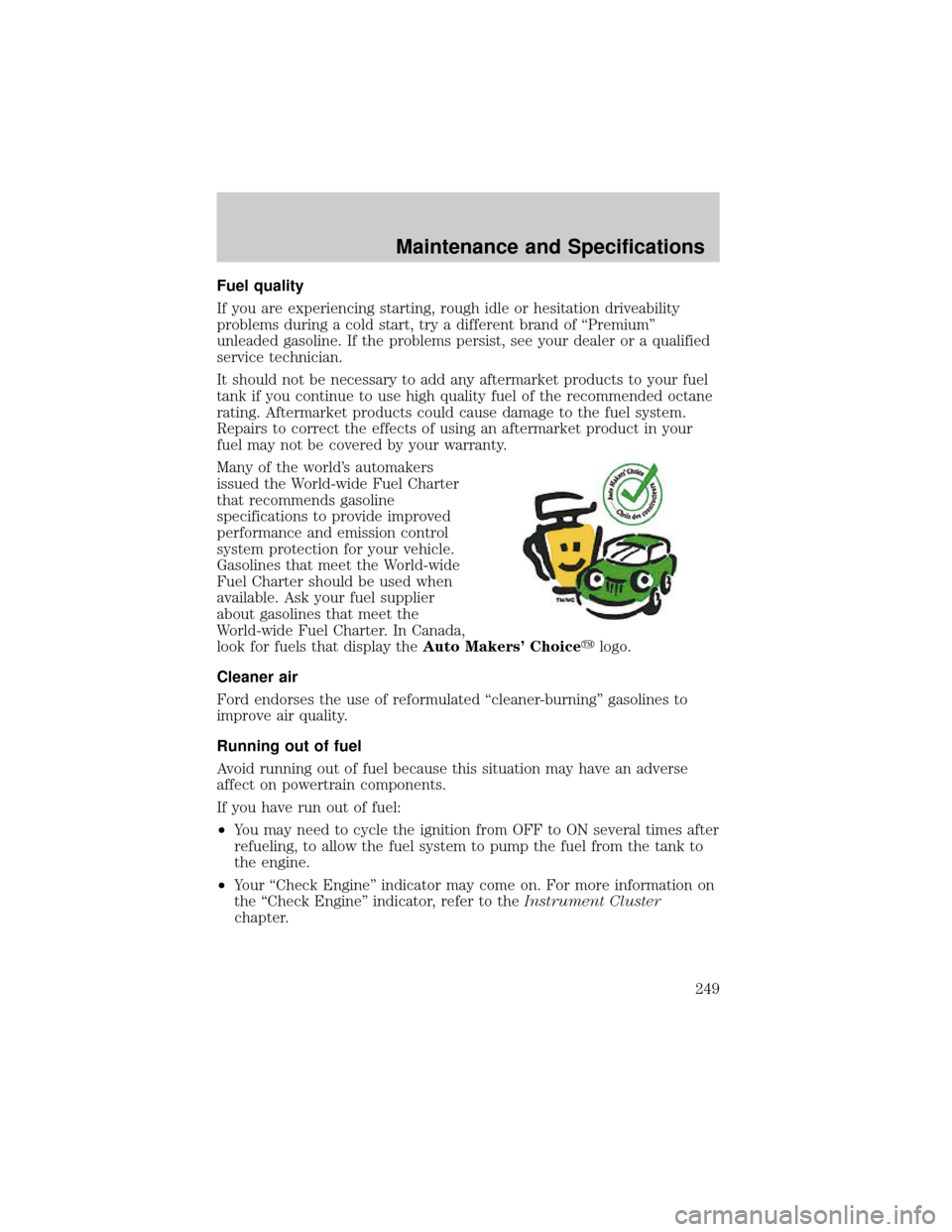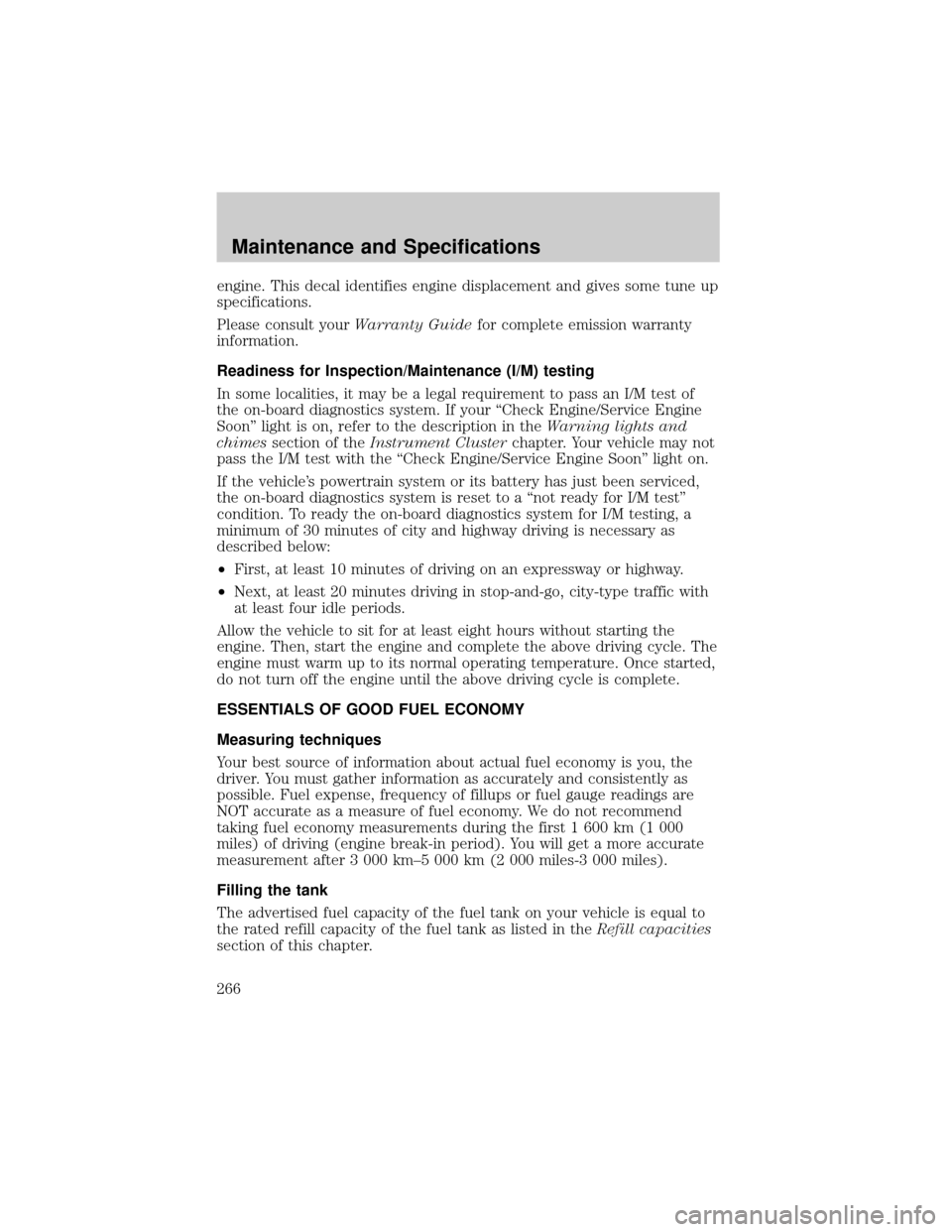Cluster LINCOLN LS 2002 Owner's Manual
[x] Cancel search | Manufacturer: LINCOLN, Model Year: 2002, Model line: LS, Model: LINCOLN LS 2002Pages: 288, PDF Size: 2.44 MB
Page 225 of 288

Do not use chemical solvents or strong detergents when cleaning
the steering wheel or instrument panel to avoid contamination of
the air bag system.
Cleaning the instrument cluster lens
Wipe the cluster area with a soft, damp cotton towel. Dry the area with a
clean, dry towel.
CLEANING SEATS EQUIPPED WITH SIDE AIR BAGS
Remove dust and loose dirt with a vacuum cleaner. In order to remove
stains and soil, clean with Extra Strength Upholstery Cleaner
(E8AZ-19523±AA).
Never saturate the seat covers with any cleaning solution.
Do not use chemical solvents or strong detergents when cleaning
the seat where the side air bag is mounted. Such products could
contaminate the side air bag system and affect performance of the side
air bag in a collision. The air bag may not function correctly and not
provide injury reduction benefits.
CLEANING THE INTERIOR FABRIC, CARPETS AND CLOTH SEATS
Remove dust and loose dirt with a vacuum cleaner. Remove light stains
and soil with Extra Strength Upholstery Cleaner (E8AZ-19523±AA).
Never saturate the seat covers with cleaning solution.
Do not use household cleaning products or glass cleaners, which
can stain and discolor the fabric and affect the flame retardent
abilities of the seat materials.
If grease or tar is present on the material, spot-clean the area first with
Spot and Stain Remover (F3AZ-19521±WA). Follow up by recleaning the
area with Extra Strength Upholstery Cleaner (E8AZ-19523±AA).
Cleaning
225
Page 249 of 288

Fuel quality
If you are experiencing starting, rough idle or hesitation driveability
problems during a cold start, try a different brand of ªPremiumº
unleaded gasoline. If the problems persist, see your dealer or a qualified
service technician.
It should not be necessary to add any aftermarket products to your fuel
tank if you continue to use high quality fuel of the recommended octane
rating. Aftermarket products could cause damage to the fuel system.
Repairs to correct the effects of using an aftermarket product in your
fuel may not be covered by your warranty.
Many of the world's automakers
issued the World-wide Fuel Charter
that recommends gasoline
specifications to provide improved
performance and emission control
system protection for your vehicle.
Gasolines that meet the World-wide
Fuel Charter should be used when
available. Ask your fuel supplier
about gasolines that meet the
World-wide Fuel Charter. In Canada,
look for fuels that display theAuto Makers' Choiceylogo.
Cleaner air
Ford endorses the use of reformulated ªcleaner-burningº gasolines to
improve air quality.
Running out of fuel
Avoid running out of fuel because this situation may have an adverse
affect on powertrain components.
If you have run out of fuel:
²You may need to cycle the ignition from OFF to ON several times after
refueling, to allow the fuel system to pump the fuel from the tank to
the engine.
²Your ªCheck Engineº indicator may come on. For more information on
the ªCheck Engineº indicator, refer to theInstrument Cluster
chapter.
Maintenance and Specifications
249
Page 266 of 288

engine. This decal identifies engine displacement and gives some tune up
specifications.
Please consult yourWarranty Guidefor complete emission warranty
information.
Readiness for Inspection/Maintenance (I/M) testing
In some localities, it may be a legal requirement to pass an I/M test of
the on-board diagnostics system. If your ªCheck Engine/Service Engine
Soonº light is on, refer to the description in theWarning lights and
chimessection of theInstrument Clusterchapter. Your vehicle may not
pass the I/M test with the ªCheck Engine/Service Engine Soonº light on.
If the vehicle's powertrain system or its battery has just been serviced,
the on-board diagnostics system is reset to a ªnot ready for I/M testº
condition. To ready the on-board diagnostics system for I/M testing, a
minimum of 30 minutes of city and highway driving is necessary as
described below:
²First, at least 10 minutes of driving on an expressway or highway.
²Next, at least 20 minutes driving in stop-and-go, city-type traffic with
at least four idle periods.
Allow the vehicle to sit for at least eight hours without starting the
engine. Then, start the engine and complete the above driving cycle. The
engine must warm up to its normal operating temperature. Once started,
do not turn off the engine until the above driving cycle is complete.
ESSENTIALS OF GOOD FUEL ECONOMY
Measuring techniques
Your best source of information about actual fuel economy is you, the
driver. You must gather information as accurately and consistently as
possible. Fuel expense, frequency of fillups or fuel gauge readings are
NOT accurate as a measure of fuel economy. We do not recommend
taking fuel economy measurements during the first 1 600 km (1 000
miles) of driving (engine break-in period). You will get a more accurate
measurement after 3 000 km±5 000 km (2 000 miles-3 000 miles).
Filling the tank
The advertised fuel capacity of the fuel tank on your vehicle is equal to
the rated refill capacity of the fuel tank as listed in theRefill capacities
section of this chapter.
Maintenance and Specifications
266
Page 277 of 288

in front seat ............................149
in rear seat ..............................149
Cleaning your vehicle
engine compartment ..............222
exterior ....................................226
instrument cluster lens ..........225
instrument panel ....................224
interior .....................................225
plastic parts ....................223±224
safety belts ..............................226
washing ....................................220
waxing .....................................220
wheels ......................................221
windows ..................................226
wiper blades ............................224
Clock ......................................24, 36
Clutch
fluid ..........................................253
operation while driving ..........177
recommended shift speeds ....178
Compass, electronic ..............74±75
calibration .................................77
set zone adjustment .................76
Console ......................................106
Controls
power seat ...............................123
steering column ........................84
Coolant
checking and adding ..............237
coolant temperature light ........13
refill capacities ................241, 261
specifications ..................263±264
Cruise control
(see Speed control) ....................78
Customer Assistance ................187
Ford accessories for your
vehicle .....................................227Ford Extended
Service Plan ............................212
Getting assistance outside
the U.S. and Canada ..............216
Getting roadside assistance ...187
Getting the service
you need .................................210
Ordering additional
owner's literature ...................217
The Dispute Settlement
Board .......................................213
Utilizing the Mediation/
Arbitration Program ...............216
D
Daytime running lamps
(see Lamps) ................................61
Defrost
rear window ..............................59
Dipstick
automatic transmission
fluid ..........................................252
engine oil .................................232
Doors
central unlocking ....................109
door ajar warning .....................15
lubricant specifications ..........263
Driving under special
conditions
through water .........................181
Dual automatic temperature
control (DATC) ...........................48
E
Emergencies, roadside
jump-starting ..........................202
Emission control system ..........265
Index
277
Page 279 of 288

H
Hazard flashers .........................188
Head restraints .........................121
Headlamps ...................................60
aiming ..................................63±64
autolamp system .......................60
bulb specifications ....................66
daytime running lights .............61
flash to pass ..............................62
high beam .................................15
replacing bulbs .........................67
turning on and off ....................60
warning chime ..........................15
Heating ........................................48
HomeLink universal
transceiver (see Garage
door opener) .........................86±89
Hood ..........................................229
I
Ignition .......................156, 264±265
removing the key ....................180
Infant seats
(see Safety seats) .....................148
Inspection/maintenance
(I/M) testing ..............................266
Instrument panel
cleaning ...................................224
cluster ................................10, 225
lighting up panel
and interior ...............................62
J
Jack ............................................198
positioning ...............................198
storage .....................................198
Jump-starting your vehicle ......202K
Keyless entry system
autolock ...................................115
Keys ...........................108, 117, 119
key in ignition chime ...............15
positions of the ignition .........156
removing from the ignition ....180
valet key ..................................108
L
Lamps
autolamp system .......................60
bulb replacement
specifications chart ..................66
cargo lamps ...............................62
daytime running light ...............61
fog lamps ...................................61
headlamps .................................60
headlamps, flash to pass ..........62
instrument panel,
dimming .....................................62
interior lamps .....................65, 67
replacing bulbs .............65, 67±68
Lane change indicator
(see Turn signal) ........................64
Lights, warning and indicator ....10
AdvanceTrac .............................13
air bag ........................................12
anti-lock brakes (ABS) ....12, 162
brake ..........................................11
bulb warning .............................14
charging system ........................12
check engine .............................10
cruise indicator .........................14
door ajar ....................................15
fuel cap light .............................11
high beam ...........................14±15
low coolant ................................13
Index
279